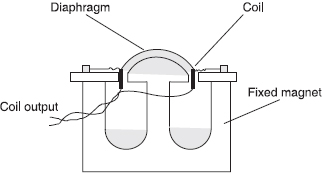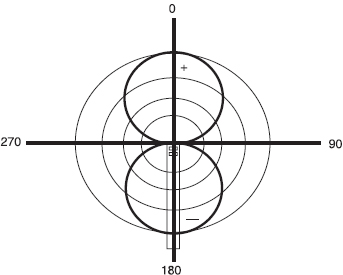37 Mics: technical information and operational summaries
A microphone capsule translates the energy from sound waves into an electrical signal. It is said to be pressure operated when the sound energy impinges on one side of its diaphragm, the other side being enclosed. When the diaphragm is open to sound waves on each side, it is said to be pressure gradient operated. The latter type tends to be more sensitive than the former, but the signal produced is lower, and thus needs a greater degree of amplification.
Moving coil
Its ‘ear’ is a diaphragm attached to a coil of wire ‘suspended’ within a magnetic field, and the energy from sound waves moves the wire within this field, thus generating (inducing) a small electric current across the coil. Hence the electrical output is derived solely from the energy imparted by the sound waves. The mic does not contain an amplifier, and so its signal output is lower than that of amplified (condenser) mics, requiring greater amplification at the camera/mixer (Figure 37.1).
Condenser
This type of mic is a variable capacitor (condenser), and requires power for its operation. Sound waves impinging on the mic capsule cause one of the plates of the capacitor (the diaphragm) to move, thus varying its capacitance. This change in capacitance across the plates is ‘seen’ as a small varying voltage which is then amplified at the mic head. This pre-amplified signal is passed back along the cable to the camera or mixer, where it requires further amplification prior to recording (Figure 37.2).

Figure 37.1 Moving coil operation

Figure 37.2 Condenser operation
Electret
Another form of condenser/capacitor design, working on a similar principle, but the capsule (ear) carries an electrostatic charge, which is sealed into the unit during manufacture. This design makes possible a very small capsule size which in itself does not, therefore, require power to energize the capacitor, but does require power for a head amplifier. Clip mics have a thin cable from capsule to head-amplifier and power pack. The output signal strength is similar to the condenser mic, and still requires amplification at the camera/mixer.
Figure-of-eight polar diagram
For M/S stereo, most mics in use on location consist of a combination of a cardiod and a figure-of-eight capsule. The polar response shows why it is called a ‘figure-of-eight’, as this capsule ‘hears’ best along one axis (which can either be considered front to back, or in a stereo sense, side-to-side), with very little pick up at 908 to this axis (Figure 37.3). The cardiod capsule captures the forward sound (providing the M signal) and the figure-of-eight provides the S information.
Mics: operational summaries
Stick (omni, dynamic)
Pros
![]() Good quality sound.
Good quality sound.
![]() Rugged/robust, no handling noise.
Rugged/robust, no handling noise.
![]() Doesn't need power.
Doesn't need power.

Figure 37.3 Figure-of-eight polar diagram
Cons
![]() Lack of sensitivity (due to lack of head amplification).
Lack of sensitivity (due to lack of head amplification).
Gun
Pros
![]() High quality.
High quality.
![]() Directional, helps minimize unwanted sound.
Directional, helps minimize unwanted sound.
Cons
![]() Bulky, if used with windshield.
Bulky, if used with windshield.
![]() Needs careful handling.
Needs careful handling.
![]() May not function well when wet.
May not function well when wet.
![]() Needs power (not necessarily a problem if phantom power is readily available).
Needs power (not necessarily a problem if phantom power is readily available).
Clip
Pros
![]() Can be relatively close to required sound source.
Can be relatively close to required sound source.
![]() Small and light, easy to carry.
Small and light, easy to carry.
Cons
![]() Personal jewellery, clothing rustle, head turn off mic.
Personal jewellery, clothing rustle, head turn off mic.
![]() Wind noise.
Wind noise.
![]() Needs power (not necessarily a problem if phantom power readily available).
Needs power (not necessarily a problem if phantom power readily available).
Pros
![]() No cables.
No cables.
Cons
![]() If using a clip mic, all relating to it, plus:-
If using a clip mic, all relating to it, plus:-
![]() Correctly siting the transmitter, receiver and aerials – line of sight transmission.
Correctly siting the transmitter, receiver and aerials – line of sight transmission.
![]() Maintaining batteries.
Maintaining batteries.
![]() RF interference.
RF interference.
![]() A licence is probably required.
A licence is probably required.
(Figures 37.1, 37.2 and 37.3 are reproduced from Multiskilling for Television Production, P. Ward, A. Bermingham and C. Wherry, Focal Press 2000.)
